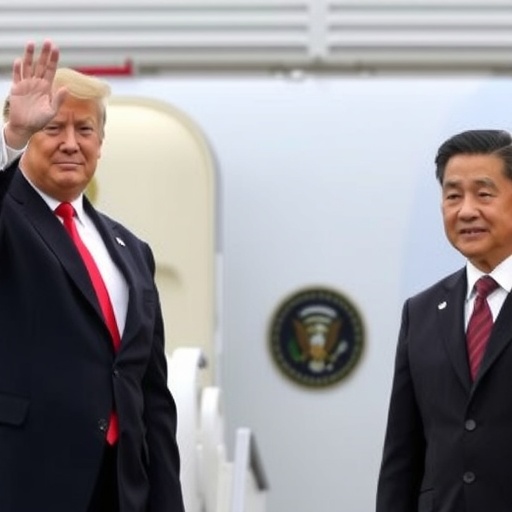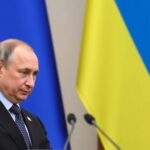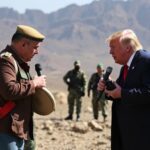Trump Launches Asia Tour with High-Stakes Japan Visit to Forge Stronger Ties with Prime Minister Takaichi
In a move that underscores America’s renewed focus on the Indo-Pacific, President Donald Trump is touching down in Tokyo today, kicking off a pivotal three-day visit to Japan as the cornerstone of his broader Asia tour. This landmark trip marks Trump‘s first face-to-face encounter with Japan’s newly appointed Prime Minister Sanae Takaichi, a conservative powerhouse whose rise to power has electrified regional politics. Amid escalating tensions with North Korea and China’s assertive maneuvers in the South China Sea, the duo’s discussions are poised to redefine the US-Japan alliance, injecting fresh momentum into one of the world’s most critical security partnerships.
The timing couldn’t be more charged. Just weeks after Takaichi’s surprise ascension to the premiership following a contentious leadership battle within the Liberal Democratic Party (LDP), Trump’s arrival signals unwavering U.S. support for Tokyo’s new guard. Sources close to the White House describe the itinerary as a “strategic reset,” blending high-level diplomacy with cultural overtures to humanize the alliance. As Trump steps off Air Force One at Haneda Airport, flanked by a delegation of top advisors and business leaders, the world watches to see if this visit can bridge ideological divides and counterbalance Beijing’s growing influence.
Trump’s Asia tour, which will extend to South Korea and the Philippines later in the week, comes at a moment of flux. Recent intelligence reports highlight North Korea’s accelerated missile tests—over 20 launches in the past six months alone—while China’s military drills near Taiwan have spiked by 40% year-over-year, according to Pentagon assessments. For Japan, these threats hit close to home, with Takaichi’s administration vowing a more proactive defense posture, including potential revisions to the country’s pacifist constitution. Trump’s visit, therefore, isn’t just ceremonial; it’s a high-wire act in geopolitical chess, where every handshake and presser could tip the scales of regional stability.
Trump’s Grand Welcome in Tokyo Signals Renewed Commitment
The pomp and circumstance of Trump’s arrival in Japan was nothing short of spectacular, evoking memories of his 2017 state visit but with an added layer of urgency. As the presidential motorcade rolled through Tokyo’s bustling streets, lined with American and Japanese flags fluttering in the crisp autumn breeze, crowds gathered in a mix of curiosity and cautious optimism. Prime Minister Takaichi, dressed in a sharp navy suit that mirrored her no-nonsense demeanor, greeted Trump at the airport with a firm handshake and a nod to shared histories: “Welcome to Japan, Mr. President. Together, we’ll build an unbreakable bond against tomorrow’s storms.”
This warm reception belies deeper undercurrents. Takaichi, a 63-year-old trailblazer who shattered glass ceilings as Japan’s first female Defense Minister in 2006, has positioned herself as a hawk on security issues. Her election in September, amid a scandal-plagued LDP, was hailed by Trump on social media as “a win for strong leaders everywhere.” The visit’s opening events included a wreath-laying at the Yasukuni Shrine—a site fraught with historical sensitivities—followed by a private dinner at the Imperial Palace, where discussions reportedly touched on economic synergies. U.S. exports to Japan hit $75 billion last year, per Commerce Department data, and Trump is pushing for tariff reductions on American autos and agriculture to boost that figure.
But beyond the optics, security loomed large. Trump, known for his blunt style, wasted no time in a brief airport statement: “Japan and the U.S. are like family—we stick together, especially when bullies like Kim Jong-un or Xi Jinping start rattling sabers.” This rhetoric aligns with Takaichi’s own pledges; in her inaugural address, she declared, “The era of passive defense is over. We’ll stand shoulder-to-shoulder with our American allies to safeguard our seas and skies.” Analysts note that this visit could accelerate joint military exercises, which have already intensified, with the U.S. deploying an additional 2,000 Marines to Okinawa bases this fiscal year.
Takaichi’s Rise and the Personal Chemistry with Trump
At the heart of this Trump-Takaichi summit is a meeting of minds that could redefine bilateral relations. Sanae Takaichi’s journey to the prime ministership is a riveting tale of resilience and revisionism. Born in Nara Prefecture, she entered politics in the 1990s, rising through LDP ranks with a platform emphasizing national pride and economic nationalism. Her appointment as education minister in 2014 drew controversy for promoting a more assertive view of Japan’s World War II history, but it also earned her Trump’s admiration—he once tweeted, “Takaichi gets it: real leaders don’t apologize for strength.”
Their first bilateral meeting, scheduled for tomorrow at the Kantei office, promises fireworks. Agenda items include bolstering the US-Japan alliance through enhanced intelligence sharing and cyber defense pacts. Takaichi has advocated for Japan to acquire offensive capabilities, such as long-range strike missiles, a shift that aligns with Trump’s “America First” doctrine of burden-sharing. “We’re not babysitters,” Trump quipped in pre-visit briefings, echoing his past criticisms of alliance inequities. Yet, insiders say Takaichi’s pragmatism—coupled with her fluency in English and affinity for Western culture—could forge a rapport that eluded previous administrations.
Personal anecdotes add color to the narrative. Both leaders share a penchant for directness; Takaichi’s memoir, Blue Eyes on Japan, recounts her admiration for Reagan-era diplomacy, while Trump’s deal-making ethos resonates with her push for a “free and open Indo-Pacific.” During the visit, they’ll tour a Toyota factory in Nagoya, highlighting industrial ties—Japan’s auto sector employs over 5 million and supplies 30% of U.S. imports. Economic talks may yield a mini-deal on semiconductors, vital amid global chip shortages that cost the U.S. economy $240 billion in 2022, according to Semiconductor Industry Association stats.
Critics, however, warn of risks. Progressive voices in Japan, like those from the Constitutional Democratic Party, decry Takaichi’s visit as a “militaristic pivot,” fearing it could alienate neighbors like South Korea. A recent Asahi Shimbun poll shows 55% of Japanese support stronger U.S. ties, but only 40% back constitutional changes. Trump’s history of unpredictable tariffs—imposing 25% on steel in 2018—lingers as a cautionary tale, though current vibes suggest collaboration over confrontation.
Navigating Regional Threats: North Korea and China in the Spotlight
No Japan visit under Trump would be complete without addressing the elephant—or rather, the dragon and the hermit kingdom—in the room. The US-Japan alliance has long served as a bulwark against North Korea’s provocations, but recent escalations demand bold action. Pyongyang’s hypersonic missile tests in October alone violated UN resolutions, prompting Takaichi to convene emergency cabinet sessions. Trump, drawing from his 2018-2019 summits with Kim Jong-un, plans to reiterate demands for denuclearization while floating incentives like eased sanctions for verifiable steps.
China poses an even thornier challenge. Beijing’s gray-zone tactics—incursions into Japanese waters near the Senkaku Islands—have surged 50% since 2020, per Japan’s Defense Ministry. Takaichi’s government is eyeing a $56 billion defense budget hike over five years, partly to fund U.S.-compatible F-35 jets. During joint pressers, expect Trump to tout the Quad alliance (U.S., Japan, Australia, India) as a counterweight, with recent naval drills in the Philippine Sea involving 20,000 personnel underscoring unity.
Expert insights enrich the discourse. Dr. Emily Chen, a fellow at the Brookings Institution, notes, “This visit is a litmus test for the alliance’s post-pandemic resilience. Takaichi’s assertiveness complements Trump’s transactional style, potentially yielding breakthroughs in supply chain security.” Indeed, amid U.S.-China trade wars, Japan has emerged as a key partner, with bilateral investments reaching $700 billion. Yet, humanitarian angles can’t be ignored; Trump and Takaichi will discuss aid for Ukraine, drawing parallels to Indo-Pacific vulnerabilities, as Russia’s invasion has emboldened authoritarian regimes globally.
Environmental and tech cooperation rounds out the agenda. With climate change exacerbating typhoon risks in Japan—2023 saw damages exceed $10 billion—Trump’s team pushes green tech exchanges, including hydrogen energy pacts. On AI and quantum computing, a new memorandum could safeguard against Chinese espionage, building on the 2023 U.S.-Japan Critical and Emerging Technologies pact.
Asia Tour’s Ripple Effects: From Tokyo to Beyond
As Trump’s Asia tour unfolds, the Japan leg sets the tone for subsequent stops, promising a cascade of diplomatic dividends. In South Korea, he’ll address THAAD missile deployments amid North Korean saber-rattling, while the Philippines visit eyes enhanced basing rights under the Enhanced Defense Cooperation Agreement. Analysts predict this itinerary could net $100 billion in trade commitments, per U.S. Trade Representative estimates, revitalizing American manufacturing.
Looking ahead, the Trump-Takaichi partnership holds transformative potential. If talks yield a formalized security roadmap—perhaps expanding the alliance to include space defense—it could deter aggression and foster economic growth. Takaichi’s domestic reforms, like digitalizing bureaucracy to cut red tape, dovetail with Trump’s deregulation ethos, potentially spurring a trans-Pacific innovation boom. Yet, challenges persist: domestic politics in both nations demand results, with midterm elections looming in the U.S. and LDP factions eyeing Takaichi warily.
The visit’s legacy will hinge on execution. As Trump departs Japan on day three, after a sumo tournament nod to cultural ties and a toast to enduring friendship, the world anticipates tangible outcomes. Will this be the spark for a fortified US-Japan alliance, or a fleeting photo-op? Early signs point to the former, with whispers of a joint declaration on Indo-Pacific stability. In an era of flux, Trump’s Tokyo sojourn reaffirms that alliances, when nurtured, remain the bedrock of global order—offering hope amid uncertainty for years to come.








